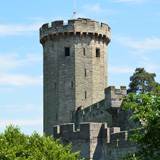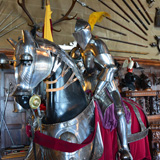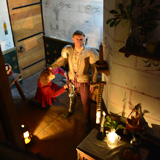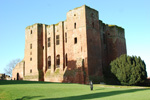History
Warwick Castle was built in 1068 on orders from William the Conqueror to consolidate his control in the midlands and north of England. It began as a simple wooden motte and bailey-style castle next to the River Avon. Born in the storm of the Norman Invasion, its history is etched in steel and blood.

William appointed Henry de Beaumont as the constable of the castle. Beaumont changed his name to de Newburgh, and five of his descendants would follow in his footsteps as Earls of Warwick. In 1153, the wife of Roger de Beaumont, 2nd Earl of Warwick, was tricked into believing her husband was dead and surrendered Warwick Castle to the army of Henry of Anjou, later King Henry II of England. Henry would later return the castle to the Earls of Warwick. The last of the Beaumont Earls of Warwick, Thomas de Beaumont, died without an heir in 1242, and the castle passed to his sister, Margaret.
By 1260, Warwick Castle's wooden walls and structures began to be replaced by stone, and a high curtain wall surrounded a shell keep and inner bailey. Twin Towers were built on the castle's east side to protect the gatehouse. Margaret's marriage to John de Plessis was also childless, and when John died in 1263, the castle passed to Margaret's cousin William Mauduit. William became the Earl of Warwick during the Barons' War and sided with the king. Unfortunately for William, the leader of the rebellious barons was Simon de Montfort, Earl of Leicester, whose stronghold, Kenilworth Castle, was just a few miles from Warwick Castle. It was no surprise that, in 1264, Warwick Castle was attacked, and William and his wife were captured and held for ransom by John Giffard, Governor of Kenilworth.
On William's death in 1268, Warwick Castle passed to his nephew, William de Beauchamp, beginning the Beauchamp dynasty that would last at the castle for almost 150 years. William de Beauchamp made a name for himself as a military commander under King Edward I.
His son, Guy de Beauchamp, was one of a group of earls known as the Ordainers. They were not happy with how King Edward II raised revenue and ran the kingdom or with the influence Piers Gaveston, a Gascon knight, had on the king. In 1312, Piers Gaveston surrendered to the earls after being promised his life would be safe. Guy de Beauchamp seized Gaveston and brought him to Warwick Castle. A quick trial was held in the Great Hall, and Gaveston was sentenced to death and beheaded on Blacklow Hill, just outside Warwick.
Guy de Beauchamp died three years later, in 1315, but his son Thomas did not succeed him as Earl of Warwick due to his young age until 1329, less than ten years before the beginning of the Hundred Years' War with France. Thomas established himself as one of King Edward III's favorite commanders, fighting at the Battle of Crecy in 1346 and the Battle of Poitiers in 1356. He was among the first men to be made a Knight of the Garter. Thomas also enhanced Warwick Castle by adding defenses such as the Barbican and heightened the twin towers on either side, now called Guy's Tower and Caesar's Tower. The Watergate Tower was also constructed during this period.
Thomas' son, Thomas the Younger, 12th Earl of Warwick, was a primary opponent of King Richard II and, along with four other lords, forced Richard to execute or dismiss some of his favorites from the court. Richard would have his revenge in 1397 when he brought those lords to trial and charged them with treason. Thomas Beauchamp was imprisoned in the Tower of London in what's now known as Beauchamp's Tower. He pleaded guilty and threw himself at the mercy of the king. He was exiled to the Isle of Man and forfeited his title and estates. When Henry Bolingbroke usurped the crown from Richard II, he restored the lands and title to Thomas.
Thomas' son Richard, 13th Earl of Warwick, was the most prominent Beauchamp of all. King Henry V made him tutor to his young son, the future Henry VI. Richard acted as superintendent of the trial of Joan of Arc, where she was found guilty of heresy and burned at the stake in Rouen, France.
The Beauchamp line died out in 1449 when Anne Beauchamp died at the age of five. The earldom of Warwick passed to her aunt, another Anne Beauchamp, and Richard Neville, Anne's husband, making Richard Neville the 16th Earl of Warwick. Richard Neville became known as the Kingmaker for helping dispose of Henry VI and Edward IV during the Wars of the Roses. But he would meet his end at the Battle of Barnet in 1471, resulting in his title and Warwick Castle being awarded to George Plantagenet, the Duke of Clarence, who himself was imprisoned and killed in 1478. The castle passed to his brother Richard of Gloucester, future King Richard III, whose wife, Anne, was Neville's younger daughter. The title of Earl of Warwick, however, passed to George's son, Edward, one of the Princes in the Tower who would meet an early death at the Tower of London as Richard became king. Richard would begin the additions of the Bear and Clarence Towers to Warwick Castle.
Warwick Castle remained in the crown's possession, and Henry VIII had work carried out to strengthen the walls on the River side of the castle. Then, in 1547, Edward VI granted the title of Earl of Warwick to John Dudley, who had helped the nine-year-old king rule immediately after Henry VIII's death. When Edward VI died, his sister Mary became Queen of England. John Dudley tried to place his daughter-in-law, Lady Jane Grey, on the throne. This coop attempt lasted for two weeks, with Mary reclaiming her right to rule and John Dudley, his son Guilford, and Lady Jane Grey all being executed for treason.
When Mary's sister Elizabeth became Queen Elizabeth I after Mary's death, she restored the Dudley name, made Ambrose Dudley, Guilford's brother, Earl of Warwick, and granted him Warwick Castle. Elizabeth visited Warwick Castle in 1566 and again in 1572, and Ambrose left the castle to the queen during her visits. When Ambrose died without an heir in 1590, the title of Earl of Warwick became extinct for the second time, and the castle reverted to the crown.
In 1604, James I presented the now-ruined castle to Sir Fulke Greville, but the Earl of Warwick title was conferred to Lord Rich in 1618, and the earldom remained in his family until 1759. In 1605, conspirators involved in the Gunpowder Plot stayed in Dunchurch Warwickshire when they received news that the plot had failed. They then stole cavalry horses from the stables of Warwick Castle to aid their escape north. Fulke Greville converted the castle into a comfortable country house, a common practice during the 15th and 16th centuries. In 1621, Fulke was created Baron Brooke, and he spent a significant sum of money renovating the castle while staying in the Watergate Tower.
On September 1st, 1628, Fulke Greville was murdered by his manservant, Ralph Haywood, who stabbed him twice after discovering he was to be omitted from Greville's will. Greville's ghost still haunts the Watergate Tower, later known as the Ghost Tower.
In 1642, Robert Greville, 2nd Baron Brooke, enhanced the defenses of Warwick Castle in preparation for an attack during the English Civil War. These enhancements included raising the height of the garden walls and constructing bulwarks to mount artillery. Greville was a Parliamentarian, and on August 7th, 1642, Royalist forces laid siege to Warwick Castle. The siege failed and was lifted on August 23rd when the castle forces were relieved, and the Royalists were forced to retreat to Worcester.
After the Battle of Edgehill in 1642, Warwick Castle held prisoners in Guy's Tower and Caesar's Tower. During the Second English Civil War, prisoners were kept at the castle again following the Battle of Worcester in 1651.
Francis Greville, 8th Baron Brooke, continued a program of improvements at Warwick Castle and its grounds. In 1759, when the Rich family died out, he was bestowed with the title Earl of Warwick, tying the Earl of Warwick title to Warwick Castle once again. Francis is credited with the gothic interior of the chapel and bringing in Lancelot "Capability" Brown to redo the grounds around the castle.
A fire in 1871 damaged the castle east of the Great Hall. It was determined that the fire was intentionally started by an under-butler who had stolen valuables from the private apartments and began the fire to conceal the theft. The fire gutted the Great Hall and apartments. Restoration work was carried out between 1872 and 1875.
By 1900, Warwick Castle had a ticket office and employed a permanent guide to show visitors the castle. In 1978, after 374 years in the Greville family, Warwick Castle was sold to the Tussauds Group, which opened it as a significant tourist attraction. In 2001, the British Tourist Authority named the castle one of Britain's "Top 10 historic houses and monuments."
Today, the castle is owned by the Prestbury Group and operated by Merlin Entertainments. It is open to visitors every day except Christmas Day.
Castle Highlights
Warwick Castle is considered one of the finest Norman Strongholds in England. It is packed with history and helped shape England's course. It is a major tourist attraction and is very busy, especially in the summer. But large crowds aside, it is well worth a visit and can easily take all day to experience everything. I have visited the castle seven times, the most of any castle I have seen.
The best room in the castle is the Great Hall. The armor displayed in Warwick's Great Hall is second only to that of the Tower of London. It contains over 1,000 pieces of arms and armor that retell the history of England, with items from giants like Oliver Cromwell and Charles Edward Stuart, better known as Bonnie Prince Charlie.
The apartments above the Great Hall are finely decorated, and wax figures of historic individuals depict a weekend party at the castle in 1898. The rooms include the Red Drawing Room, Cedar Drawing Room, Green Drawing Room, Queen Anne Bedroom, Royal Weekend Party, Library, Music Room, and others to explore.
The Kingmaker exhibit is another attraction at the castle. It tells the story of Richard Neville, 16th Earl of Warwick, through different scenes of his rise and preparation for battle.
You can take a one-way walk up to the top of Guy's Tower, over the battlements to the Barbican, and then up to the top of Caesar's Tower to get spectacular views of the castle and grounds.
And being a tourist attraction, new shows or events happen almost every hour, from falconry shows to jousting and a giant trebuchet on the yard across the River Avon from the castle.
If you manage to see the whole castle in less than a full day and want more to do, Kenilworth Castle is just a few miles away.
Warwick Castle is also haunted.



